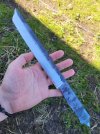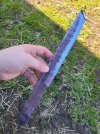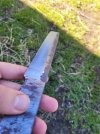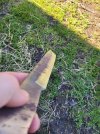Use a 12-14" flat file. A mill bastard will do fine. If you buy one new, spend the extra few dollars for a 14" coarse Nicholoen Magi-cut. It is an amazing file for blades.
If you have a handle for the file, put it on the file tang. If not wrap it heavily in tape. Wrap the last 2" of the file with several layers of masking or duct tape.
Hold the file in both hands at a 30° angle from perpendicular and draw it down the blade from plunge to tip. Move the file from bottom of the file to top as you make the draw. Lift the file and return it to the start point. Avoid "sawing" the file back and forth. Metal will shave off in little slivers. WEAR GLOVES and wipe off frequently. Once you get the feel for it you can shave down a sword blade flat and smooth quickly. Once you switch to 100 grit paper, draw the paper (wrapped around a hardwood block) down the blade from plunge to tip in long even strokes. Try not to sand back and forth any more than needed. Long smooth firm strokes work best. Sand up to 400-grit or as high as you want. 400 looks OK for a rough use sword shaped object. I have heard that a 220-grit finish does well on Zombies, but you need a smoother surface for a T-rex. Maybe Larrin will do some testing on that.
Make up a pan with 1 qt/L water with 1Tsp/5ml of dish soap and one Tbs/15ml. of baking soda in it. Dip the sanding block in it every few strokes as needed to keep the sanding wet. Chance the water and wash your hands and the block off when you change the paper grit to a finer one.
Wipe it dry when quitting for the day/night and apply a light coat of oil (any type) to keep rust at bay.
Don't panic if you see some red rust film on the surface the next day. It is flash rust and wipes off with the first sanding stroke.
Tip:
If you plan on doing a lot of hand filing, places like Zoro sell Magicut files in lots of 6 for just a few bucks over $20 a file. Well worth the investment.
Also, check out flea markets and blacksmith trunk sales. I have bought a 50# box of used files for $10 at a hammer-in. Some are pretty well worn, but some were near new. I don't care (see next tip).
There are file sharpening services that are reasonable. I haven't tried the citric acid (or vinegar) reconditioning method on old files but have heard some folks use it with good results to get a second life from old files.
Tip #@:
Old flat, half-round, round, and square files can be forged into really neat snakes. It is fun and they sell like crazy. Once you get the method down, it takes 15 minutes start to finish to make a $50 snake. I often do this at demos. It is sooooo much fun! I often have tossed one down in the grass/pine straw and let people spot it themselves. It is funny to hear someone holler, "SNAKE!"
Here is a thread on it:
Sunday afternoon I had a young man (18) over to work on a sword project. He had designed it last year and asked if I would make it for/with him . I told him it would be his graduation present. I had done all the metal work on the blade, and we were working on the habaki, fittings, and tsuka. Up to now, he has just watched the hot work. More on that project at a later time.
After we were done with the afternoon's work in the forge, I asked him if he wanted to have some fun. He was all, "Oh Yeah!". I rummaged in my "metal for projects" bucket and pulled out a 7-8" tapered half round rasp...
BTW, that young lad is now an Army officer at Ft. Benning.
Another file snake (not mine):
View attachment 2804031





